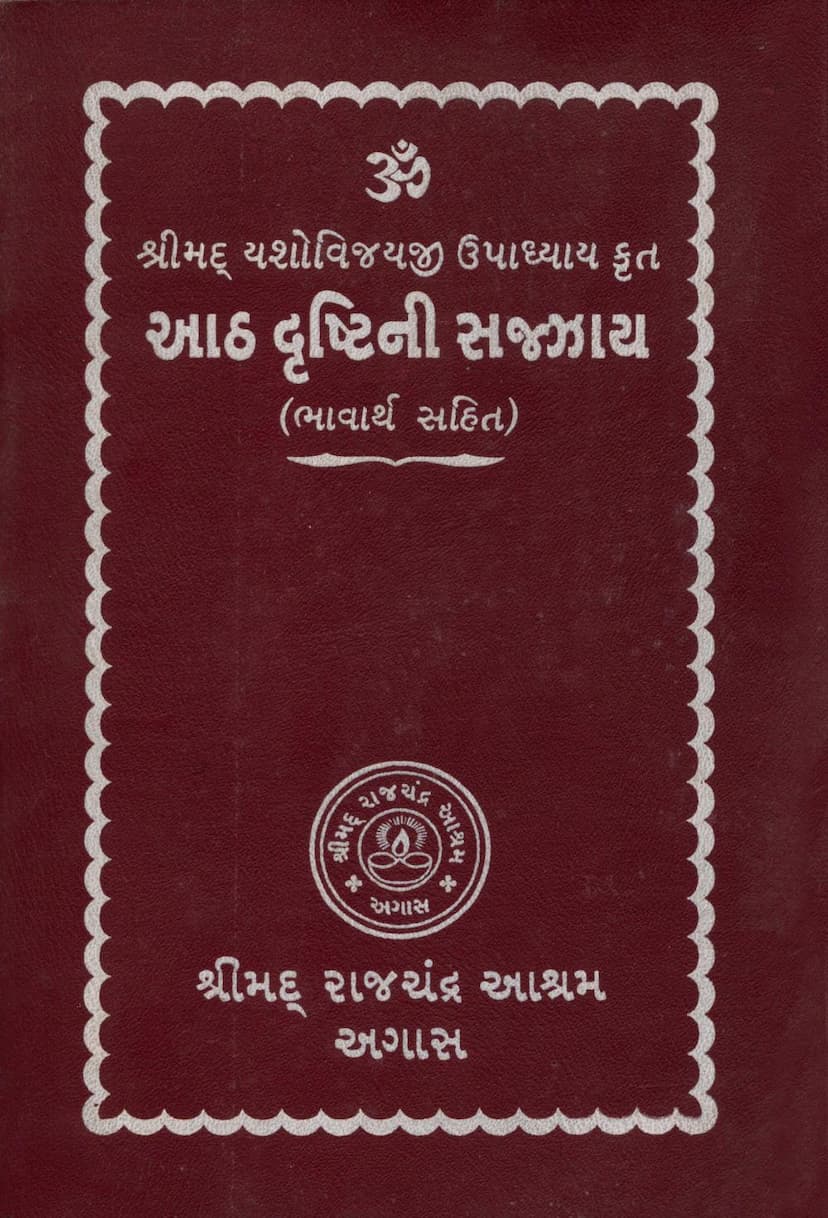Aath Drushtini Sazzay
Added to library: September 1, 2025

Summary
Here's a comprehensive summary of the Jain text "Aath Drushtini Sazzay" by Govardhandas Maharaj, based on the provided pages:
Book Title: Aath Drushtini Sazzay (The Eight Types of Vision/Perspectives) Author: Shri Yashovijayji Upadhyay Compiled/Edited by: B. Govarhandasji B.A. Publisher: Shrimad Rajchandra Ashram, Agas Context: This book is a Gujarati translation and commentary (bhavarth) of a Sanskrit work, "Yogdrishti Samuccaya" by Shri Haribhadrasuri. The "Aath Drushtini Sazzay" is a poetic rendering of the eight stages of spiritual vision described in Haribhadrasuri's work, adapted into Gujarati by Shri Yashovijayji.
Core Concept: The "Aath Drushtini Sazzay" describes eight distinct stages or perspectives (Drishti) that a soul progresses through on its path to liberation (Moksha). These eight perspectives are likened to a "thermometer for the soul's state" (Aatma Dashamapak Tharmometer Yantra), serving as a diagnostic tool to understand one's spiritual progress and identify areas for improvement. The text emphasizes the importance of these perspectives for spiritual seekers, particularly those aiming for self-realization and liberation.
Key Themes and Structure:
-
Authorship and Lineage: The book is based on the Sanskrit work of Shri Haribhadrasuri and is presented in Gujarati by Shri Yashovijayji. The commentary is provided by Govardhandas Maharaj, and the publication is from the Shrimad Rajchandra Ashram, highlighting the influence of Shrimad Rajchandra's teachings. Shrimad Rajchandra himself recommended the study of these eight perspectives and provided extensive commentary on the sixth perspective in his letters.
-
The Eight Perspectives (Drishti): The eight perspectives are presented in a progressive order, moving from initial spiritual inquiry to the final state of liberation. Each perspective has a name, an analogy, associated yogic practices (Ang), the defects (Dosh) that are overcome, and the virtues (Gun) that are attained.
- 1. Mitra Drishti (Friendly Vision): Characterized by initial spiritual awakening, akin to the spark of fire in dry grass. It involves basic ethical observances (Yama) and overcoming lethargy and aversion. The focus is on the initial steps of spiritual practice and the importance of seeking a true guru.
- 2. Tara Drishti (Star Vision): Represents a more sustained spiritual fervor, like the heat of cow-dung fire. It involves adherence to rules (Niyama), overcoming agitation, and developing a deep curiosity (Jijnasa) about the true nature of reality.
- 3. Bala Drishti (Strong Vision): This stage shows a more stable understanding, like fire in wood. It involves overcoming restlessness and developing concentration (Aasan) and a strong desire to listen (Shrvan Sammiha) to spiritual teachings.
- 4. Deeksha Drishti (Initiation/Vision of Self-Control): Approaching the stage of true knowledge, akin to the light of a lamp. It involves breath control (Pranayama) and overcoming the illusion of worldly pleasures (Utthan). The focus is on purifying one's perception and developing strong faith.
- 5. Sthira Drishti (Steadfast Vision): Represents a stable state of spiritual insight, like the continuous light of a jewel. It involves withdrawal of senses (Pratyahara), overcoming illusions, and attaining subtle knowledge (Sukshma Bodh). The soul begins to experience a glimpse of its true nature.
- 6. Kanta Drishti (Beloved Vision): A stage where the soul finds profound satisfaction in spiritual teachings, like the light of stars. It involves concentration (Dharana), overcoming attachment to external opinions (Anyamud), and deep contemplation (Mimansa) of truths.
- 7. Prabha Drishti (Radiant Vision): Characterized by sustained meditation, like the radiance of the sun. It involves meditation (Dhyana), overcoming desires and afflictions (Roga), and attaining profound understanding (Pratipatti).
- 8. Para Drishti (Supreme Vision): The ultimate stage of spiritual perfection, like the soothing light of the moon. It involves perfect absorption (Samadhi), overcoming all attachments (Asanga), and attaining complete liberation.
-
Spiritual Progression: The eight perspectives illustrate a gradual unfolding of spiritual awareness and practice. The first four are preparatory, leading to the attainment of right faith (Samyak Darshan). The latter four describe the stages of advanced spiritual realization and practice, culminating in liberation.
-
The Importance of the Guru and Scriptures: The text consistently emphasizes the crucial role of a spiritual teacher (Sadguru) and the guidance of scriptures (Agam). True spiritual understanding and progress are achieved through diligent study, contemplation, and adherence to the teachings of enlightened beings.
-
Overcoming Defects and Cultivating Virtues: Each stage involves shedding negative tendencies (dosha) and cultivating positive qualities (guna). This process leads to an inner transformation, moving the soul from delusion and suffering towards equanimity and bliss.
-
Analogy of the Wife's Devotion: The commentary frequently uses the analogy of a devoted wife's unwavering love for her husband to illustrate the ideal of a seeker's devotion to spiritual truth and the Guru. This emphasizes single-pointed focus and dedication.
-
The Purpose of the "Sazzay": The "Sazzay" (poetic verses with commentary) is intended to help seekers deeply understand and internalize these eight spiritual perspectives, thereby strengthening their spiritual practice and guiding them towards their ultimate goal of liberation.
Summary of the Purpose and Value:
"Aath Drushtini Sazzay" serves as a guide for spiritual aspirants, offering a framework for understanding their progress on the path to liberation. By internalizing and reflecting upon these eight perspectives, individuals can:
- Self-Diagnose: Understand their current spiritual state and identify areas needing improvement.
- Cultivate Virtues: Actively develop the virtues associated with each stage.
- Overcome Defects: Shed negative tendencies that hinder spiritual growth.
- Strengthen Practice: Deepen their meditation, contemplation, and ethical conduct.
- Appreciate the Path: Gain a profound understanding of the stages leading to ultimate bliss and freedom.
The book is presented as a valuable tool for those earnestly seeking self-realization and spiritual enlightenment, reinforcing the teachings of esteemed Jain scholars and saints.